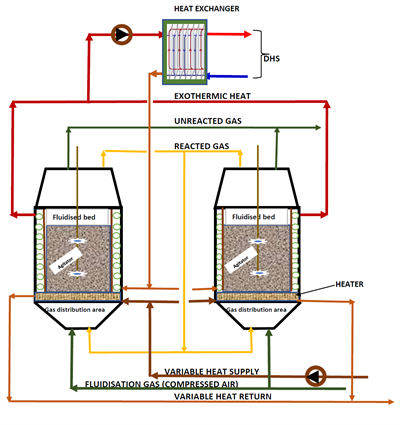Key aims and expertise
The overarching aim of this project is to develop a thermochemical energy storage - district heating system using a co-design framework working at micro, macro and meso scales, that will contribute to reductions in carbon emissions, leading to more effective use of renewable and low carbon resources, whilst meeting societal and economic needs.The specific objectives are therefore to:
- Develop a co-design framework that will allow the development of the thermochemical energy storage and district heating systems, addressing technical, social, economic, and political drivers and constraints.
- Gain a context-specific understanding of the socioeconomic, environmental, and political factors for district heating, incorporating macro-, meso-, and micro-level actors.
- Simulate through advanced computer modelling optimal designs for a novel double-acting agitated fluidised bed thermochemical storage system analysing the chemical and thermodynamic properties
- Build a pilot thermochemical energy storage system using novel double-acting agitated fluidised bed system and integrate it for testing into the existing district heating network test bed facility.
- Evaluate the thermal and energy performance, socio-economic and environmental feasibility ofthe integrated technology.
The VTTESS project brings together a cross-disciplinary team of investigators and reserarchers with expertise in district heating and low carbon technology, materials science, business development, social science and policy.
Our industrial partners (Hubl Ltd, NRGSense Ltd and Sustainable Direction Ltd), and a local district heating provider (Nottingham City Council) will bring their experience in large scale low carbon energy production, storage and district heating.
University of Nottingham will lead the engineering and science works, with input from our industrial partners, and Aston University will lead on socio-economic and policy works. Business development and social policy investigators at University of Nottingham is working in close collaboration with those at Aston University to integrate research and development in technical, scientific, social, economic and policy areas.
Our technology
How it works?
The system involves a very unique double-acting agitated heat recovery and heat charging mechanism to store and discharge the heat. The system also consists of two fluidised beds of inorganic oxide compounds that have very high energy density. The heat can be stored in this material and then at a later date be reactivated by means of chemical reaction.
 The project is looking at the most effective material to store heat for later application. Basic materials are commercially-available but they have limitations. Part of the research is to characterise all available materials in the lab and then enhance their heat transfer capabilities.
The project is looking at the most effective material to store heat for later application. Basic materials are commercially-available but they have limitations. Part of the research is to characterise all available materials in the lab and then enhance their heat transfer capabilities.
Why is it a game changer?
While conventional thermochemical energy storage systems require intermittent operation, thanks to the mechanism and material to be developed for the project, the novel system proposed will operate continuously at variable temperatures.
To maximise its supply, the new system will be able to collect heat from different sources and temperatures. It will be flexible and smart; able to sense the temperature that is being delivered and store it appropriately. It will also be relatively cheap to run compared to conventional systems, which store heat in large water tanks at fixed temperature. At domestic level, it removes the fossil fuel cost, and the financial burden of boiler purchase, servicing and maintenance.
Our system is decentralised. With that you can minimise the amount of heat lost through very long communal heating pipe systems. It can retain the energy in its absorbed state, with near-zero losses and so potentially allow storage inter-seasonally, e.g. storing solar energy in summer during low demand and discharging in winter during high demand.
Significant results and publications
Kur, A.; Darkwa, J.; Calautit, J.; Boukhanouf, R.; Worall, M. Solid–Gas Thermochemical Energy Storage Materials and Reactors for Low to High-Temperature Applications: A Concise Review. Energies 2023, 16, 756. https://doi.org/10.3390/en16020756